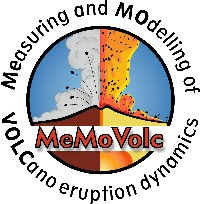MeMoVolc report on classification and dynamics of volcanic explosive eruptions
Bonadonna C., R. Cioni, A. Costa, T. Druitt, J. Phillips, L. Pioli, D. Andronico, A. Harris, S. Scollo, O. Bachmann, G. Bagheri, S. Biass, F. Brogi, K. Cashman, L. Dominguez, T. Dürig, O. Galland, G. Giordano, M. Gudmundsson, M. Hort, A. Hoskuldsson, B. Houghton, J.C. Komorowski, U. Kueppers, G. Lacanna, J.L. Le Pennec, G. Macedonio, M. Manga, I. Manzella, M. de’Michieli Vitturi, A. Neri, M. Pistolesi, M. Polacci, M. Ripepe, E. Rossi, B. Scheu, R. Sulpizio, B. Tripoli, S. Valade, G. Valentine, C. Vidal, and N. Wallenstein (2016).
Bulletin of Volcanology, 78/11, 84, doi:10.1007/s00445-016-1071-y.
Abstract
Classifications of volcanic eruptions were first introduced in the early twentieth century mostly based on qualitative observations of eruptive activity, and over time, they have gradually been developed to incorporate more quantitative descriptions of the eruptive products from both deposits and observations of active volcanoes. Progress in physical volcanology, and increased capability in monitoring, measuring and modelling of explosive eruptions, has highlighted shortcomings in the way we classify eruptions and triggered a debate around the need for eruption classification and the advantages and disadvantages of existing classification schemes. Here, we (i) review and assess existing classification schemes, focussing on subaerial eruptions; (ii) summarize the fundamental processes that drive and parameters that characterize explosive volcanism; (iii) identify and prioritize the main research that will improve the understanding, characterization and classification of volcanic eruptions and (iv) provide a roadmap for producing a rational and comprehensive classification scheme. In particular, classification schemes need to be objective-driven and simple enough to permit scientific exchange and promote transfer of knowledge beyond the scientific community. Schemes should be comprehensive and encompass a variety of products, eruptive styles and processes, including for example, lava flows, pyroclastic density currents, gas emissions and cinder cone or caldera formation. Open questions, processes and parameters that need to be addressed and better characterized in order to develop more comprehensive classification schemes and to advance our understanding of volcanic eruptions include conduit processes and dynamics, abrupt transitions in eruption regime, unsteadiness, eruption energy and energy balance.


